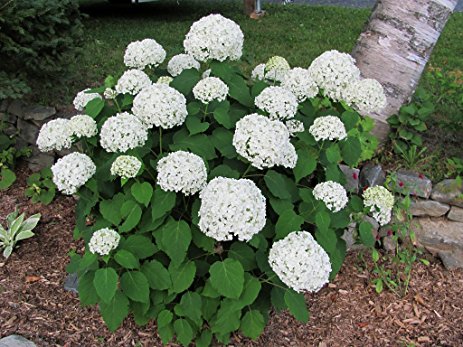
General information
Scientifc name: Hydrandrea arborescens
There reportedly are about seventy-five (75) species of Hydrandrea. Another popular species used medicinally is Hydrangea macrophylla.
Other names: Mountain Hydrangea, Seven Barks, Smooth Hydrangea, Wild Hydrangea, Hortensia
Family: Hydrangeaceae
Habitat: Indigenous to the eastern U.S. as far south as Florida.
Chemical constituents
Hydrangea contains Hydrangin (a glucoside), saponin, resin, two oils (one fixed and the other volatile), two resins, gum, sugar, starch, albumin, calcium sulphide (radio-active), potassium sulphate, sodium acid phosphate (stone solvent), magnesium phosphate and sulphate, a protosalt of iron. It contains no tannin.
Use
The leaves, roots and flowers are anti-malarial, antitussive and is a mild diuretic. It is considered an effective treatment for prostate inflammation and urinary stones – both preventative and also dissolving stones already formed. Hydrangea root/bark is considered one of the most effective urinary tract analgesics. It is used for genito-urinary tract pain and spasms.
Urinary tract disorders, frequent urination, accompanied by a sense of burning and sharp, quick pain in the urethra. Pain from the irritation of passing renal sand. Aching in the back with irritation and partial suppression of urine, dizziness, chest tightness. It is considered an effective remedy in cystitis, calculi, renal irritation, hemorrhage, pain and inflammation.
The leaves contain phellodulcin, a very sweet substance that can be used as a sugar substitute. One small leaf is sufficient to sweeten a cup of tea. The older leaves can be dried, powdered and used as flavouring on foods. The young leaves and shoots are also eaten cooked.
Research/Study
Diabetes: Rats were divided into three groups – normal control; diabetic control and diabetic. Hydrangea dulcis folium (HDF) supplement (fermented leaves with hot water extract @ 40g/kg diet) was fed for 3 weeks. The HDF significantly decreased the serum glucose concentrations, increased insulin level and improved glucose homeostasis in diabetic control rats. The total cholesterol and triglyceride concentrations in the serum and liver were also markedly reduced in HDF treatment group.
Parts Used Medicinally
Rhizome, root.
Dosage
Tea: Add 1⁄2 – 1 teaspoon dried bark to 8 oz. cool water, steep for at least 1 hour. Take 4 oz.
Tincture (1:5): 2-3 ml
Capsules: up to 9 size “O” capsules daily. Typical dosage would be short term for 4-6 days.
For preventative measures: Use 1-2 capsules daily for long term use.
Decoction: 3 cups daily.
Dried rhizome/root 2–4 g as a decoction three times daily.
Liquid extract 2–4 mL (1 : 1 in 25% alcohol) three times daily.
Caution
No health hazards or side effects are known in conjunction with the proper administration of designated therapeutic dosages. According to information in older medical literature, the intake of larger dosages can lead to dizziness, feelings of constriction in the chest and central nervous system disorders.
Side-effect/Toxicity
There is a lack of clinical safety and toxicity data for hydrangea.
Hydrangea has been reported to cause contact dermatitis, and hydrangin (a constituent of hydrangea) may cause gastroenteritis.
Source:
Herbal Medicines Third edition pub. 2007 by Joanne Barnes, Linda A Anderson, J David Phillipson
PDR for Herbal Medicine pub. 2000 by Joerg Gruenwald, PhD etal
A Textbook of Materia Medica and Therapeutics of Rare Homeopathic Remedies pub. 1899 by Oscar Hansen MD
Dr Edward Shook’s Famous Course in Herbalogy published by Herbs of Mexico 2010
Disclaimer:The information provided here are for educational purposes only, and is meant to help users better understand health concerns. This information should not be interpreted as specific medical advice. Users should consult with a qualified health care provider for specific questions regarding therapies, diagnosis and/or health conditions, prior to making therapeutic decisions.
DISCLAIMER: THIS WEBSITE DOES NOT PROVIDE MEDICAL ADVICE
The information, including but not limited to, text, graphics, images and other material contained on this website are for informational purposes only. The purpose of this website is to promote broad consumer understanding and knowledge of various health topics. It is not intended to be a substitute for professional medical advice, diagnosis or treatment. Always seek the advice of your physician or other qualified health care provider with any questions you may have regarding a medical condition or treatment and before undertaking a new health care regimen, and never disregard professional medical advice or delay in seeking it because of something you have read on this website.